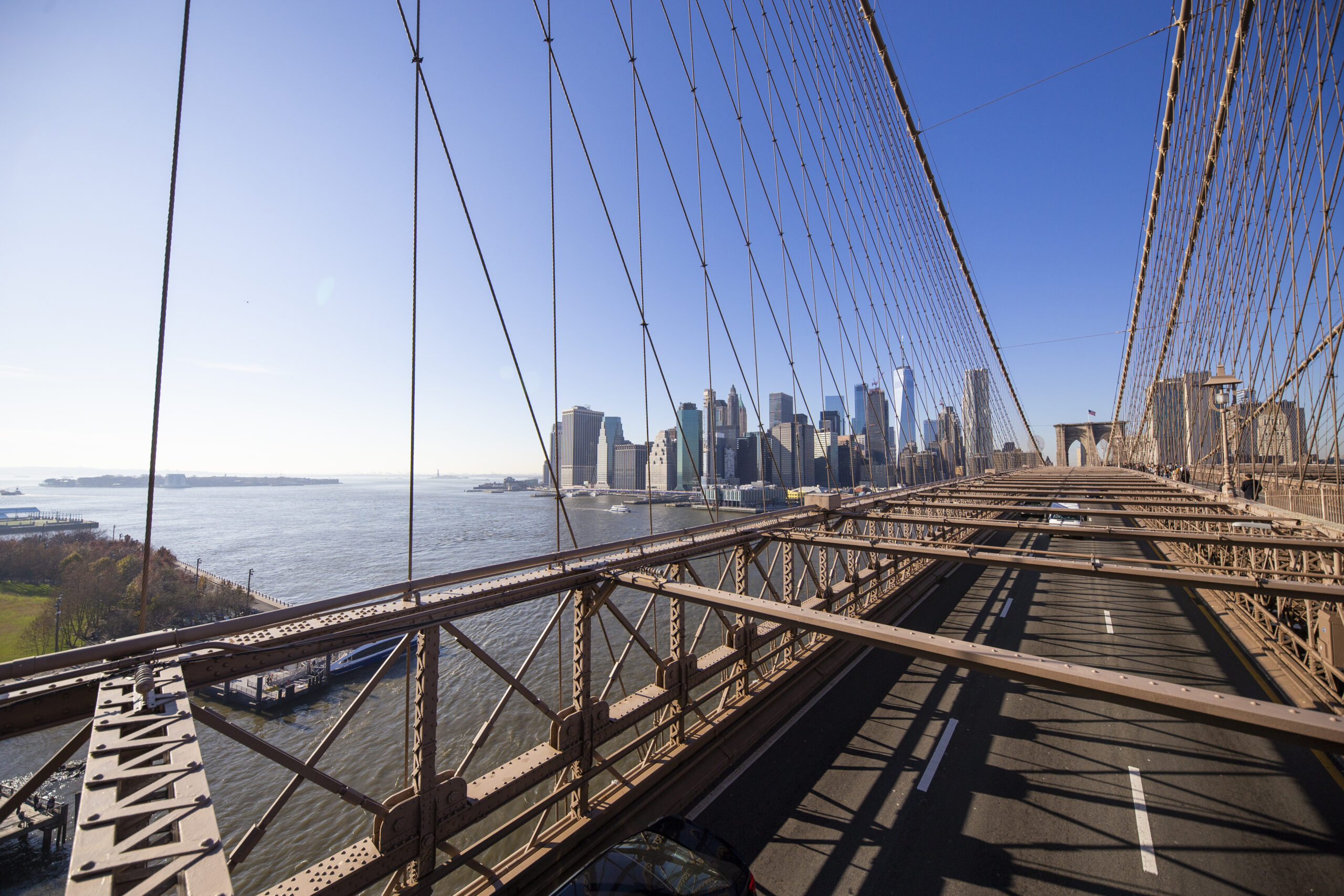Think of New York City, and you’re likely to envision its skyscrapers touching the sky and streets teeming with life. But there’s another aspect of the city’s charm that deserves a nod – the bridges in NYC. These aren’t just mere structures; they’re feats of engineering, cultural landmarks, and architectural wonders all rolled into one. And here’s a fun fact: including the Washington Bridge twice, because of its unique path in and out of the Bronx, there are 20 bridges in NYC that link Manhattan to its surrounding boroughs. That’s how NYC keeps itself connected, showcasing its ability to amaze and unite.
So, have you seen all the bridges in NYC that connect Manhattan? If not, prepare to be amazed as we embark on a journey to explore the bridges that have shaped the city’s skyline and have become iconic symbols of New York City. From the world-famous Brooklyn Bridge to the lesser-known Roosevelt Island Bridge, each bridge has its own unique history, engineering marvels, and cultural relevance.
Let’s check out New York City’s bridges together. We’ll find out what makes them special, from their design to their history. Whether you live here or are just passing through, there’s something cool about these bridges. Ready to see what makes them stand out?
History of Bridges in New York City
In the vibrant city of New York, bridges form an integral part of its history and infrastructure. The early needs of a growing metropolis led to the construction of bridges, evolving from simple crossings to engineering marvels we see today. Key figures, such as John Roebling and Othmar Ammann, played a significant role in shaping the landscape of bridge design and construction in New York.
Early needs for bridges in a growing metropolis.
The history of bridges in New York City can be traced back to the 17th century when the first bridge, known as the King’s Bridge, was built. As the city grew rapidly, the need for bridges became evident as they facilitated transportation and connectivity between different boroughs. With Manhattan being an island, bridges were crucial for expanding the city’s boundaries and connecting it to surrounding areas.
Evolution from simple crossings to engineering marvels.
Over the years, bridge designs in New York City have evolved immensely. What started as simple crossings transformed into extraordinary engineering marvels. Advancements in materials, construction techniques, and architectural design led to the construction of iconic bridges that are landmarks of the city today. These bridges not only provide transportation links but also serve as symbols of engineering prowess and architectural excellence.
Key figures in bridge design and construction.
The evolution of bridges in New York City owes much to the vision and expertise of notable bridge designers and engineers. John Roebling, a renowned engineer, is credited with designing the iconic Brooklyn Bridge, which was a groundbreaking engineering achievement of its time. Othmar Ammann, another influential figure, designed several prominent bridges in the city, including the George Washington Bridge and the Triborough Bridge. These individuals, along with many others, have left a lasting impact on the landscape of New York City through their innovative bridge designs and contributions to bridge engineering.
When you think about the story of New York City’s bridges, it’s really a story about the city itself – growing, changing, and reaching new heights. In the beginning, as the city expanded, there was a clear need to connect its sprawling boroughs. What started as simple crossings evolved into some of the most incredible examples of bridge design you’ll see anywhere in the world. And let’s not forget the incredible minds behind these designs! These bridges aren’t just practical structures; they’re symbols of what human ingenuity can achieve. They’re a big part of what makes New York, well, New York.
General Facts about NYC’s Bridges
New York City is home to a vast network of bridges, with a total of 789 bridges connecting the boroughs. These bridges span various water bodies and exhibit a diverse range of bridge types, including suspension, cable-stayed, and arch bridges. The bridges in NYC play a crucial role in urban planning and transportation, providing vital links for both vehicles and pedestrians.
Total number of bridges in New York City
New York City boasts an impressive 789 bridges that connect the boroughs. These bridges stand as remarkable structures, crossing water bodies and enabling seamless transportation for the bustling city. The sheer number of bridges in NYC showcases the importance of these architectural feats in the city’s infrastructure.
The diversity of bridge types
The bridges in New York City exhibit a rich variety of architectural and engineering styles. From suspension bridges, like the iconic Brooklyn Bridge, to cable-stayed bridges such as the Manhattan Bridge, and arch bridges like the Washington Bridge, each bridge represents a unique design and construction approach. This diversity adds to the beauty and functionality of the city’s bridges.
Importance of bridges in urban planning and transportation
The bridges in NYC play a vital role in urban planning and transportation. They connect different boroughs, facilitating the movement of people, goods, and services. Besides providing a physical link, bridges also contribute to the city’s aesthetic appeal, enhancing the skyline and creating iconic landmarks. Furthermore, bridges offer pedestrians and cyclists safe routes, promoting alternative modes of transportation and healthier urban living.
| Bridge Type | Example |
|---|---|
| Suspension | Brooklyn Bridge |
| Cable-stayed | Manhattan Bridge |
| Arch | Washington Bridge |
Bridges connecting Manhattan to Brooklyn
Brooklyn and Manhattan are linked together by several iconic bridges, each with its own fascinating history and architectural beauty.
Brooklyn Bridge
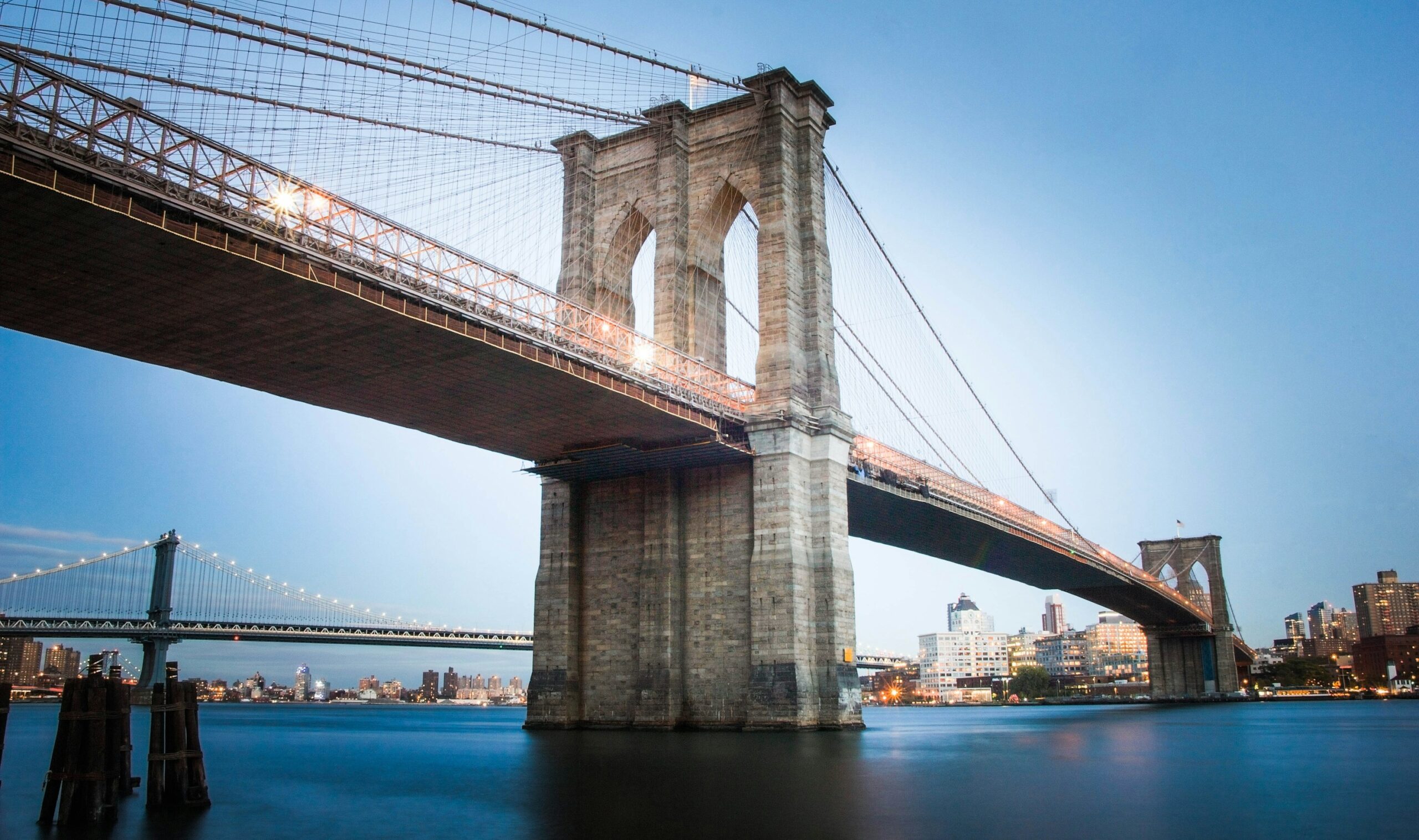
The Brooklyn Bridge, probably the most iconic of bridges in NYC. Spanning the East River, it connects the boroughs of Manhattan and Brooklyn, serving as a vital artery for commuters and tourists alike.
- Historical Significance: Completed in 1883, the Brooklyn Bridge was the first steel-wire suspension bridge ever constructed, marking a significant advancement in bridge engineering.
- Designer: John Augustus Roebling conceived the design, with his son, Washington Roebling, overseeing the project’s completion.
- Length and Dimensions: The bridge spans approximately 1,595 feet and stands 276 feet above the East River at its highest point.
- Construction Challenges: Challenges included the depth of the East River and accommodating ship traffic.
- Innovative Design: Roebling’s design combined the strength of steel cables with the stability of stone towers.
- Architectural Features: The bridge’s Gothic-style towers are constructed from limestone, granite, and Rosendale cement.
- Pedestrian Walkway: The elevated walkway offers stunning views of the Manhattan skyline and the East River.
- Cultural Landmark: The bridge has become a cultural icon, featured in countless films, TV shows, and works of literature.
- Maintenance and Preservation: Regular maintenance ensures the bridge’s continued safety and functionality.
Over the years, the Brooklyn Bridge has become a cultural landmark and a symbol of New York City’s resilience and spirit. It has been featured in countless films, television shows, and works of literature, cementing its status as an enduring icon of the city. Despite its age, the Brooklyn Bridge remains structurally sound thanks to regular maintenance and preservation efforts, ensuring its continued safety and functionality for generations to come.
Manhattan Bridge
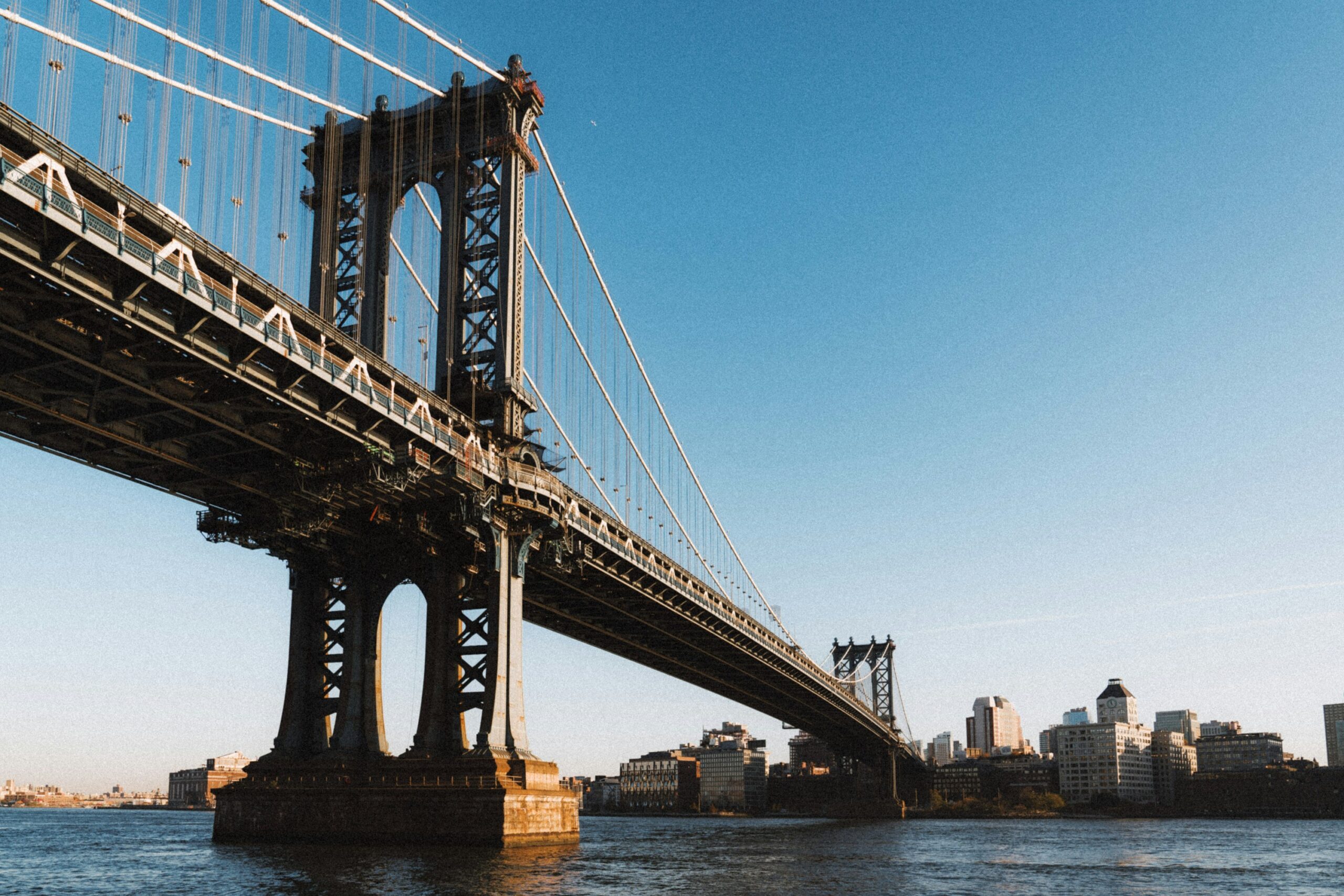
The Manhattan Bridge, another iconic structure in New York City, provides a vital link between the boroughs of Manhattan and Brooklyn, contributing to the city’s bustling transportation network.
- Historical Significance: Completed in 1909, the Manhattan Bridge is one of the city’s most recognizable landmarks, representing a significant achievement in bridge engineering during the early 20th century.
- Designer: Leon Moisseiff, an American engineer, designed the bridge, incorporating innovative techniques and materials to ensure its strength and durability.
- Length and Dimensions: The Manhattan Bridge spans approximately 6,855 feet (2,089 meters) and stands 336 feet (102 meters) above the East River at its highest point.
- Construction Challenges: Similar to the Brooklyn Bridge, the Manhattan Bridge faced challenges related to the depth of the East River and the need to accommodate ship traffic during construction.
- Architectural Features: Unlike its Gothic-style counterpart, the Manhattan Bridge features a more utilitarian design, characterized by its steel suspension cables and distinctive tower structure.
- Pedestrian Walkway and Transit: The bridge accommodates vehicular traffic, subway lines, and pedestrian walkways, providing essential transportation options for residents and visitors alike.
- Cultural Impact: While perhaps less renowned than the Brooklyn Bridge, the Manhattan Bridge still holds cultural significance, often appearing in films, photography, and other forms of media.
- Maintenance and Preservation: Like any aging infrastructure, the Manhattan Bridge requires ongoing maintenance and preservation efforts to ensure its continued safety and functionality. Regular inspections and repairs help to address wear and tear caused by weather, traffic, and other factors.
The Manhattan Bridge, with its distinctive design and historical significance, continues to serve as a vital link between Manhattan and Brooklyn, contributing to the city’s vibrancy and connectivity.
Williamsburg Bridge
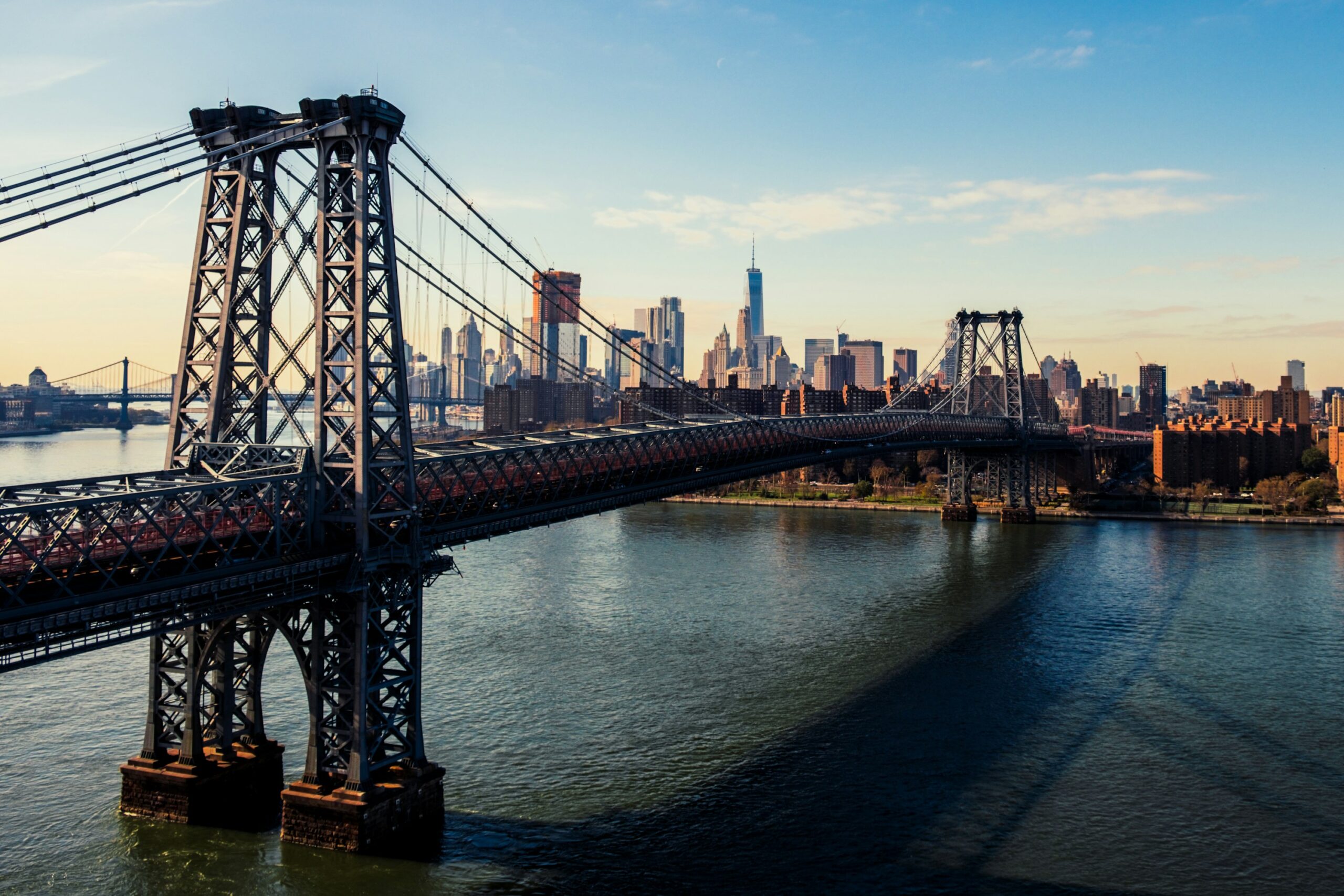
The Williamsburg Bridge, an integral part of New York City’s transportation infrastructure, spans the East River, connecting the Lower East Side of Manhattan with the Williamsburg neighborhood in Brooklyn.
- Historical Significance: Completed in 1903, the Williamsburg Bridge is one of the oldest suspension bridges in the United States, representing a significant engineering achievement of the early 20th century.
- Designer: The bridge was designed by Leffert L. Buck and Henry Hornbostel, with Buck serving as the chief engineer. Their innovative design incorporated elements of both suspension and cantilever bridge types.
- Length and Dimensions: The bridge spans approximately 7,308 feet (2,227 meters) and stands 135 feet (41 meters) above the East River at its highest point.
- Construction Challenges: Constructing the Williamsburg Bridge presented numerous challenges, including the need to accommodate heavy traffic and the bustling maritime activity of the East River.
- Architectural Features: The bridge features a distinctive truss design, with steel towers and suspension cables supporting the roadway. Its utilitarian aesthetic reflects the engineering principles of the early 20th century.
- Pedestrian and Bicycle Access: In addition to vehicular traffic, the Williamsburg Bridge includes dedicated pedestrian and bicycle lanes, providing safe passage for non-motorized commuters.
- Cultural Significance: While perhaps less iconic than the nearby Brooklyn Bridge, the Williamsburg Bridge holds cultural significance as a vital link between Manhattan and Brooklyn. It has appeared in numerous films, photographs, and works of literature, reflecting its importance in the city’s collective imagination.
- Maintenance and Preservation: Like other historic bridges in New York City, the Williamsburg Bridge requires regular maintenance and preservation efforts to ensure its continued safety and functionality. Ongoing inspections and repairs address the effects of aging, weather, and heavy usage.
Despite its age, the Williamsburg Bridge remains a crucial component of New York City’s transportation network, facilitating the movement of people and goods between Manhattan and Brooklyn while serving as a symbol of the city’s engineering prowess and enduring spirit.
These three bridges connecting Manhattan and Brooklyn not only provide crucial connections between the boroughs but also showcase the remarkable engineering achievements of their time. They have become iconic symbols of New York City and are important to the city’s architecture and innovation.
Bridges Connecting Manhattan to Queens
Manhattan and Queens are linked by two prominent bridges that play a crucial role in transportation and connectivity between the two boroughs.
Queensboro Bridge

The Queensboro Bridge, also known as the 59th Street Bridge, is a bustling thoroughfare that connects the vibrant boroughs of Manhattan and Queens. Its distinctive cantilever design, conceived by renowned engineer Gustav Lindenthal, has made it an iconic fixture of the New York City skyline since its completion in 1909. Serving as both a vital transportation link and a symbol of urban connectivity, the Queensboro Bridge embodies the city’s spirit of innovation and resilience.
- Historical Significance: Opened in 1909, the Queensboro Bridge is an essential part of the city’s infrastructure.
- Designer: Gustav Lindenthal designed the bridge, reflecting the engineering prowess of the early 20th century.
- Length and Dimensions: The bridge spans approximately 3,724 feet (1,128 meters) and stands 135 feet (41 meters) above the East River.
- Construction Challenges: Challenges included the river’s depth and heavy traffic demands during construction.
- Architectural Features: Its graceful steel structure and ornamental detailing distinguish the Queensboro Bridge as a landmark of industrial-era design.
- Transportation Hub: Accommodating vehicular traffic, subway lines, and pedestrian walkways, the bridge facilitates movement between Manhattan and Queens.
- Cultural Significance: Immortalized in literature and music, the Queensboro Bridge holds cultural significance as a symbol of New York City’s urban landscape.
- Maintenance and Preservation: Regular maintenance ensures the bridge’s continued safety and functionality, preserving its historic integrity for future generations.
Roosevelt Island Bridge (Connects Queens and Roosevelt Island)

The Roosevelt Island Bridge provides access to Roosevelt Island from Queens, crossing the eastern half of the East River. This bridge plays a vital role in connecting the residents and visitors of Queens to the charming Roosevelt Island. It offers convenient access to the island’s amenities, parks, and attractions.
| Bridges | Location | Noteworthy Features |
|---|---|---|
| Queensboro Bridge | Spans the East River, connecting Midtown Manhattan to Queens | Iconic cantilever design, scenic views of Manhattan skyline |
| Roosevelt Island Bridge | Crosses the eastern half of the East River, connecting Queens to Roosevelt Island | Essential access to Roosevelt Island’s amenities and attractions |
Bridges Connecting Manhattan to the Bronx
Manhattan and the Bronx are connected by a series of bridges that serve as vital transportation links. These bridges not only provide essential access between the two boroughs but also contribute to the historical and architectural richness of the area.
Robert F. Kennedy Bridge
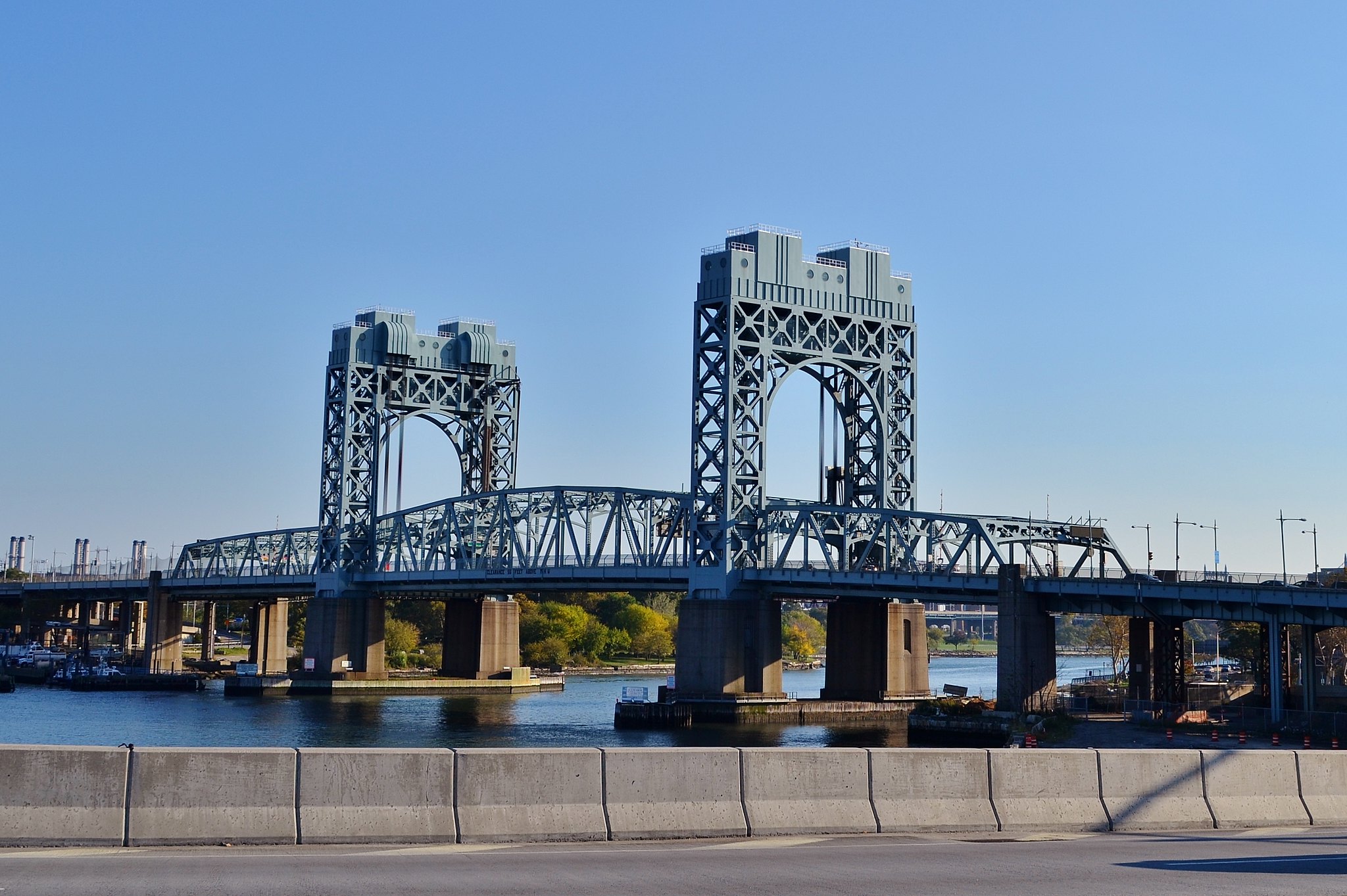
The Robert F. Kennedy Bridge, formerly known as the Triborough Bridge, is one of the most significant crossings between Manhattan and the Bronx. This bridge is an iconic symbol of connectivity, joining the three boroughs of Manhattan, Queens, and the Bronx. The Robert F. Kennedy Bridge is an architectural marvel and an essential link for commuters and travelers alike.
Henry Hudson Bridge

The Henry Hudson Bridge is another important bridge connecting Manhattan to the Bronx. This suspension bridge spans the Harlem River, providing a picturesque gateway between the two boroughs. The Henry Hudson Bridge is renowned for its elegant design and engineering excellence, offering stunning views of the surrounding area.
Other Bridges connecting Manhattan with the Bronx
Washington Bridge, University Heights Bridge, Broadway Bridge, Macombs Dam Bridge, High Bridge, Alexander Hamilton Bridge, Willis Avenue Bridge, Third Avenue Bridge, Madison Avenue Bridge, 145th Street Bridge, Spuyten Duyvil Bridge
| Bridge | Key Facts | Architectural Uniqueness | Historical Relevance |
|---|---|---|---|
| Washington Bridge (Harlem River) | Length: 2,375 feet Design: Arch bridge Year opened: 1888 | Distinctive stone arches Elegant Renaissance Revival detailing | Significant historical landmark Key transportation link |
| University Heights Bridge | Length: 1,270 feet Design: Swing bridge Year opened: 1908 | Swing mechanism for river traffic Ornate Beaux-Arts architectural elements | Historic engineering marvel Critical connection between Manhattan and the Bronx |
| Broadway Bridge | Length: 2,470 feet Design: Vertical-lift bridge Year opened: 1962 | Vertical-lift span for passing ships Sleek mid-century modern design | Advanced engineering solution Essential artery for vehicular and pedestrian traffic |
| Macombs Dam Bridge | Length: 2,540 feet Design: Bascule bridge Year opened: 1953 | Accessible pedestrian walkways Prominent concrete counterweights | Historically significant Key connection for sports fans and commuters |
| High Bridge Greenway | Length: 1,450 feet Design: Arch bridge Year opened: 1848 | Oldest bridge in New York City Victorian Gothic architectural style | Historic landmark Historical significance as a vital water supply route |
| Alexander Hamilton Bridge | Length: 2,375 feet Design: Arch bridge Year opened: 1963 | Graceful arches and cable-stayed structure Distinctive Art Deco-inspired design | Named after Alexander Hamilton Important link for vehicular traffic |
| Willis Avenue Bridge | Length: 3,212 feet Design: Swing bridge Year opened: 1901 | Swing mechanism for river traffic Steel truss construction | Historically significant Key connection for commuters and pedestrians |
| Third Avenue Bridge | Length: 1,356 feet Design: Swing bridge Year opened: 1898 | Swing mechanism for river traffic Elegant Beaux-Arts architectural style | Significant historical landmark Essential crossing for vehicular and pedestrian traffic |
| Madison Avenue Bridge | Length: 1,892 feet Design: Swing bridge Year opened: 1910 | Swing mechanism for river traffic Distinctive Beaux-Arts architectural detailing | Historically significant Key artery between Manhattan and the Bronx |
| 145th Street Bridge | Length: 1,320 feet Design: Swing bridge Year opened: 1905 | Swing mechanism for river traffic Cast-iron features and ornate detailing | Historic landmark Essential link for vehicular and pedestrian traffic |
| Spuyten Duyvil Bridge | Length: 880 feet Design: Bascule bridge Year opened: 1900 | Basque mechanism for passing ships Significant historical features | Historic landmark Key connection for boats and pedestrians |
These bridges, including University Heights Bridge, Broadway Bridge, Macombs Dam Bridge, High Bridge, Alexander Hamilton Bridge, Willis Avenue Bridge, Third Avenue Bridge, Madison Avenue Bridge, 145th Street Bridge, and Spuyten Duyvil Bridge, are all crucial components of the transportation network, architectural beauty, and historical significance of Manhattan and the Bronx.
Bridges connecting Manhattan to New Jersey
Washington Bridge
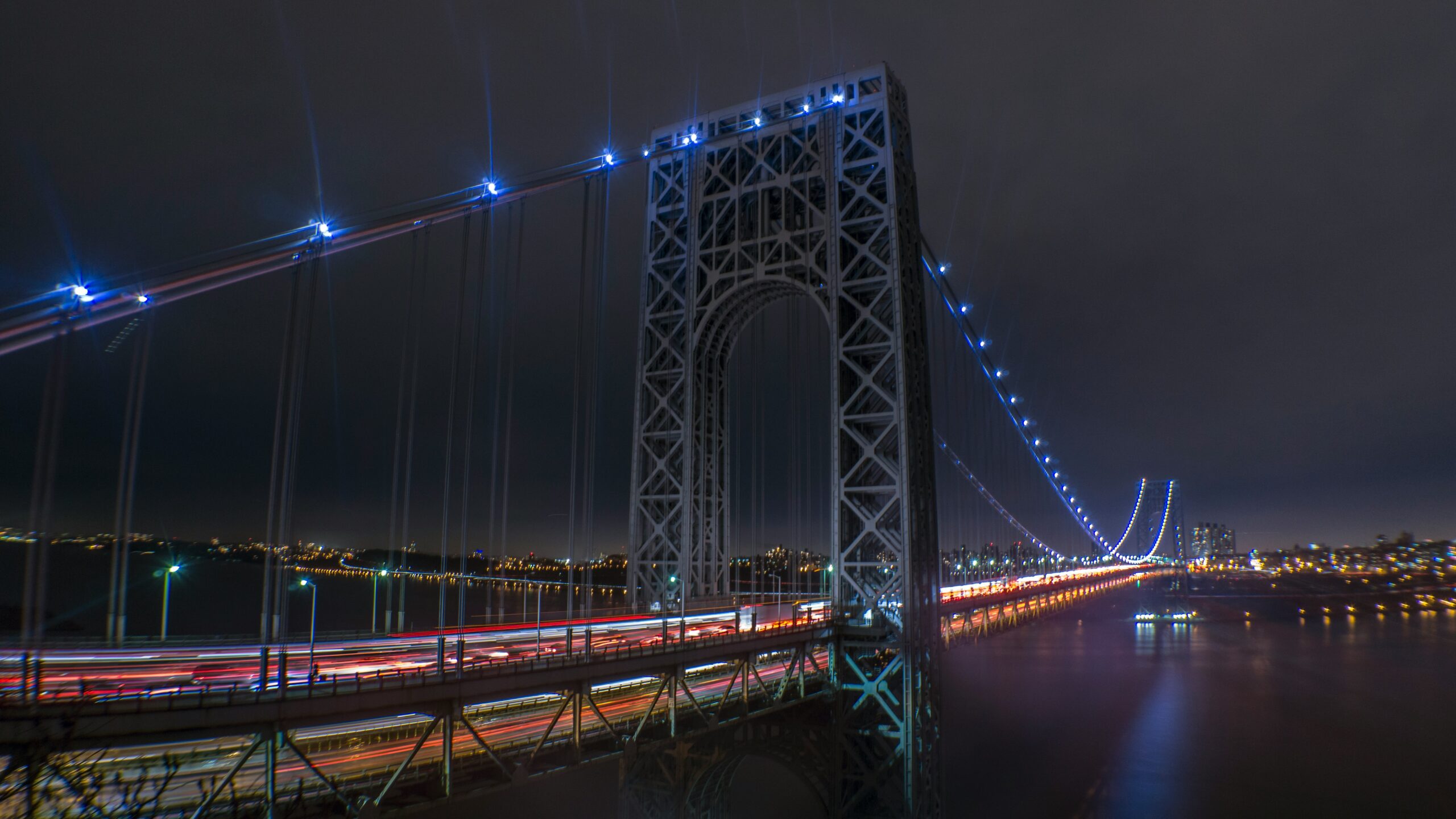
The Washington Bridge, spanning the Harlem River in New York City, serves as a vital link between the boroughs of Manhattan and the Bronx. Designed by Alfred P. Boller, it opened in 1888 and was initially a railroad bridge before accommodating vehicular traffic. Its distinctive steel arches and stone towers provide an iconic silhouette against the city skyline. The bridge’s significance extends beyond transportation, symbolizing the growth of New York City and the engineering prowess of its era. Today, it remains a crucial artery for commuters and tourists alike, embodying the city’s rich history and enduring resilience. Washginton Bridges also ha
Engineering and Architectural Masterpieces
The bridges in New York City are not just functional structures but also engineering and architectural marvels. These bridges showcase the remarkable breakthroughs achieved in bridge design and construction, as well as the innovative use of materials and techniques. Each bridge has its own unique engineering features and architectural style, contributing to the awe-inspiring landscape of the city.
Engineering breakthroughs
The engineering achievements of NYC’s bridges are truly remarkable. The Brooklyn Bridge, for example, is a feat of engineering genius with its innovative suspension system. Designed by John Roebling, this iconic bridge revolutionized bridge construction and set new standards for strength and stability. It served as a model for future suspension bridges around the world.
Another engineering marvel is the Verrazzano-Narrows Bridge, known for its modern and striking design. This suspension bridge spans the entrance to New York Harbor and was once the longest suspension bridge in the world. It showcases the use of advanced engineering techniques to ensure its stability and durability in the face of harsh weather conditions and heavy traffic.
Architectural styles and innovations
The architectural styles of NYC’s bridges are as diverse as the city itself. The George Washington Bridge, for example, showcases the Art Deco style popular during its construction in the 1930s. This bridge stands tall with its distinctive towers and intricate detailing, making it a true architectural gem.
Innovation in bridge design is also evident in the Manhattan Bridge, with its unique hybrid cable-stayed and suspension structure. This bridge represents a fusion of different engineering principles, allowing for increased spans and improved load-bearing capabilities.
Overall, the engineering marvels and architectural styles of NYC’s bridges are a testament to the ingenuity and creativity of the designers and engineers involved. These bridges continue to inspire awe and admiration, serving as iconic landmarks that define the city’s skyline and symbolize human progress.
| Bridge | Engineering Marvel | Architectural Style |
|---|---|---|
| Brooklyn Bridge | Suspension system | Neo-Gothic |
| Manhattan Bridge | Hybrid cable-stayed and suspension system | Steel truss |
| Verrazzano-Narrows Bridge | Advanced suspension system | Modern |
| George Washington Bridge | Art Deco detailing | Art Deco |
Bridges as cultural and social landmarks
The bridges in NYC aren’t just pathways from one borough to another; they’ve evolved into iconic symbols that shape the city’s very soul. These structures have leapt from the realm of utility to become key players in New York’s cultural and social scene. Take the Brooklyn Bridge, for instance, which has not just featured in “Spider-Man” but has become a staple backdrop for countless cinematic moments. Or consider the Williamsburg Bridge, offering those quintessential Manhattan skyline views that Woody Allen famously captured in “Manhattan.” These bridges in NYC aren’t just part of the scenery; they’re stars in their own right, capturing the hearts of filmmakers and audiences alike.
Photographers, too, find their muse in the sweeping lines and unique architecture of NYC’s bridges. Whether it’s the timeless grace of the Brooklyn Bridge or the sleek lines of the Verrazzano-Narrows Bridge, these structures provide a canvas for stunning visuals. The images that emerge not only highlight the engineering and aesthetic prowess of these bridges but also cement their status as enduring symbols of New York City.
But the influence of these bridges extends beyond the silver screen and glossy photo prints. They’ve woven themselves into the city’s social fabric, creating vibrant communal spaces that welcome everyone. Imagine the simple joy of a leisurely stroll across the Brooklyn Bridge, a casual picnic nestled under the Manhattan Bridge, or a serene sunset view from the High Bridge. These moments underscore the bridges’ role as more than mere conduits for traffic; they’re gathering places where people from all walks of life can connect, creating a shared sense of community and belonging in the bustling city.
FAQ
How many bridges are there in New York City?
New York City is home to a vast network of bridges, with a total of 789 bridges connecting the boroughs. There are 20 bridges in NYC that are linked to Manhattan, including
What types of bridges can be found in NYC?
The bridges in NYC exhibit a diverse range of bridge types, including suspension, cable-stayed, and arch bridges.
What is the importance of bridges in New York City?
Bridges in NYC play a crucial role in urban planning and transportation, providing vital links for both vehicles and pedestrians.
Which is the oldest suspension bridge in New York City?
The Brooklyn Bridge, completed in 1883, is one of the oldest suspension bridges in the United States and an iconic symbol of the city.
How many bridges connect Manhattan to Brooklyn?
Brooklyn and Manhattan are connected by several iconic bridges, including the Brooklyn Bridge, Manhattan Bridge, and Williamsburg Bridge.
What are the key bridges connecting Manhattan to Queens?
The key bridges connecting Manhattan to Queens are the Queensboro Bridge, also known as the Ed Koch Queensboro Bridge, and the Roosevelt Island Bridge.
Which are the bridges that connect Manhattan to the Bronx?
The bridges connecting Manhattan and the Bronx include the Robert F. Kennedy Bridge, Henry Hudson Bridge, Washington Bridge, University Heights Bridge, Broadway Bridge, Macombs Dam Bridge, High Bridge, Alexander Hamilton Bridge, Willis Avenue Bridge, Third Avenue Bridge, Madison Avenue Bridge, 145th Street Bridge, and Spuyten Duyvil Bridge.
What are some remarkable engineering breakthroughs showcased by NYC’s bridges?
The bridges in NYC showcase remarkable engineering breakthroughs, such as the suspension system of the Brooklyn Bridge and various innovative techniques and materials used in their construction.
How have bridges in New York City become cultural and social landmarks?
The bridges in NYC have transcended their functional purpose to become cultural and social landmarks. They have been featured in numerous movies, serve as iconic symbols of the city, and have created public spaces and gathering spots that are integral parts of the city’s identity.



